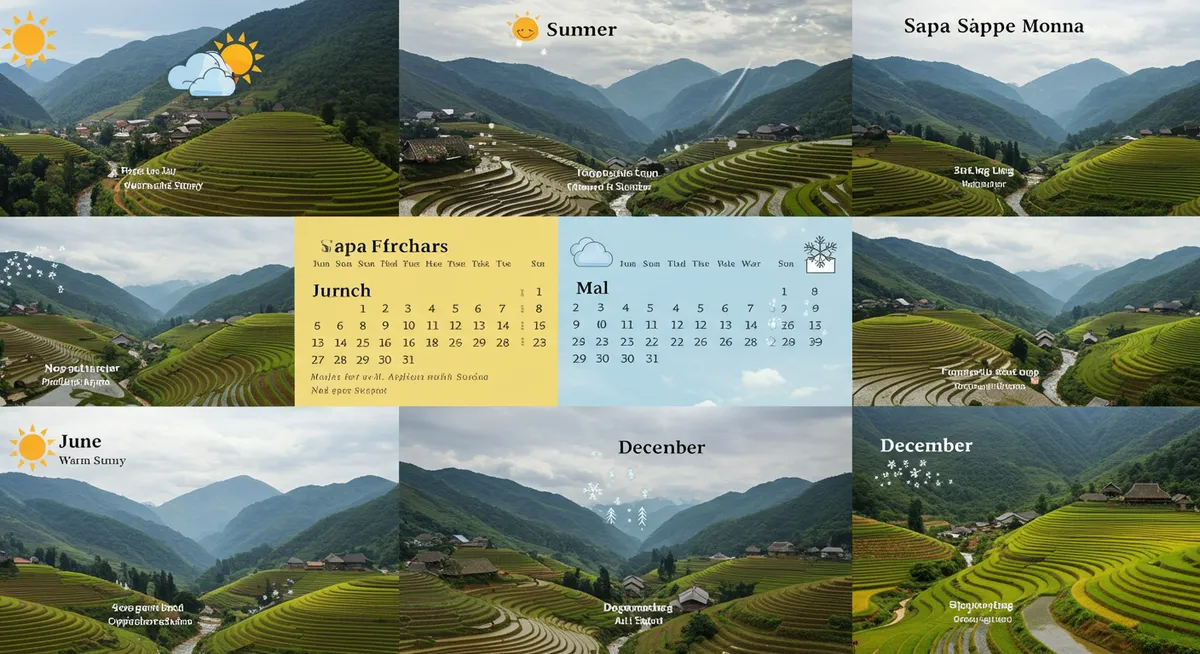
Sapa Weather by Month: Your Guide to Year-Round Travel
Table of Contents
Want to find the best travel deals for this destination? Chat with our travel hacking specialist!
Get Travel HacksCategory: sapa-weather-by-month
Sapa Weather by Month: A Seasonal Guide for Your Trip
Having personally explored Sapa's breathtaking landscapes across various seasons, I can attest that understanding its unique climate is crucial for an unforgettable journey. Sapa, nestled high in Vietnam's Hoàng Liên Son mountains, experiences four distinct seasons, each offering a different charm. From misty mornings to vibrant rice paddies, the local Sapa weather by month fluctuates significantly. This guide, part of a broader resource for planning your Asia vacation, will help you navigate the seasonal changes, ensuring you pack appropriately and plan your activities for the best possible experience. Knowing what to expect allows you to fully immerse yourself in the region's culture and natural beauty, making your trip truly seamless.
Sapa in Spring: Misty Blooms & Gentle Warmth (March - May)
Spring in Sapa, spanning March to May, ushers in milder temperatures and clearer skies, making it a truly pleasant time to visit. While some morning mist might linger, especially in March, it often burns off to reveal stunning vistas. The average Sapa weather by month during this period sees daytime highs ranging from 15°C to 25°C, with cooler nights. This gentle warmth coaxes various flowers into bloom, painting the hillsides with vibrant colors. Furthermore, the terraced rice fields begin to fill with water, reflecting the sky beautifully. I found this period perfect for hiking, as the trails are less slippery than during the rainy season, offering excellent conditions for Sapa trekking tours. It’s ideal for those seeking comfortable exploration before the intense summer heat or heavy rains.
Sapa in Summer: Lush Greenery & Occasional Rains (June - August)
From June to August, Sapa embraces its summer persona, characterized by higher temperatures and the onset of the rainy season. Average daytime temperatures hover around 20°C to 29°C, with nights remaining relatively warm. While the humidity can be noticeable, this period transforms the terraced rice fields into a breathtaking, vibrant green spectacle, a truly iconic sight for any traveler. Downpours, often intense but brief, typically occur in the afternoons, bringing relief and refreshing the air. I learned quickly that a good rain jacket is your best friend during these months, ensuring you stay dry while exploring the lush landscapes. Despite the rain, summer in Sapa is fantastic for witnessing the full glory of the rice paddies and enjoying general insights from a comprehensive Sapa travel guide.
Sapa in Autumn: Golden Rice Fields & Clear Skies (September - November)
Autumn, from September to November, is widely regarded as the prime time to experience Sapa's unparalleled beauty. The Sapa weather by month during this period is remarkably stable, featuring comfortable daytime temperatures between 15°C and 25°C, with crisp, clear nights. This is the harvest season, when the terraced rice fields ripen into a magnificent golden hue, creating postcard-perfect vistas. The air is often dry and clear, offering expansive views of Fansipan and the surrounding valleys. From my experience, booking accommodation and tours well in advance is essential during this peak season, as many consider it the best time to visit Sapa. The trekking conditions are superb, and the cultural festivals often held during this time add an extra layer of charm.
Sapa in Winter: Cool Mists & Potential Frost (December - February)
Winter in Sapa, from December to February, offers a dramatically different, often ethereal, experience. The Sapa weather by month can be quite chilly, with daytime temperatures ranging from 5°C to 15°C and frequently dropping close to freezing at night. This period is characterized by persistent mist and fog, which can occasionally obscure views but also lend the landscape a mystical, almost otherworldly atmosphere. While rare, snow or frost can occur, especially on higher elevations, transforming the landscape into a winter wonderland. I recall one winter morning when the mist was so thick, it felt like walking through a cloud. Getting to Sapa in these conditions requires a bit more planning; knowing how to get to Sapa from Hanoi during winter can be crucial for comfort and safety.
Frequently Asked Questions
What is the best time to see golden rice fields in Sapa?
Does it snow in Sapa during winter?
When is Sapa's rainy season and how does it affect travel?
Understanding Sapa weather by month is undoubtedly the key to unlocking the best of this captivating region. Whether you seek the golden splendor of autumn, the lush vitality of summer, the delicate blooms of spring, or the mystical allure of winter, Sapa offers a unique experience year-round. Each season presents its own charm and challenges, making informed planning essential. By considering the seasonal conditions, you can ensure your trip aligns with your desired activities, from trekking through vibrant rice paddies to simply soaking in the misty mountain atmosphere. Prepare wisely, and Sapa will surely leave an indelible mark on your travel memories.